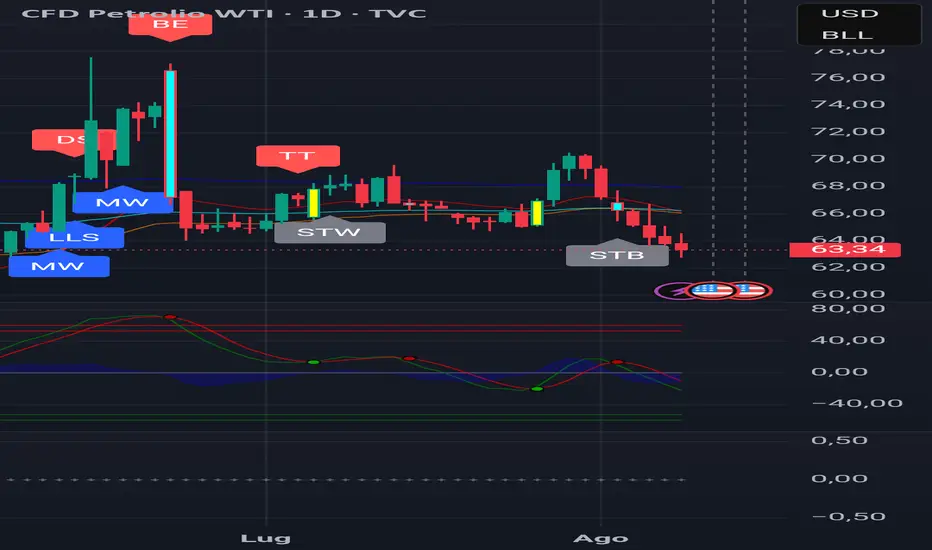$MARKETSCOM:OIL
1) More barrels are coming (or not leaving)
2) Demand side is cooling / less elastic at these prices
3) Macro & trade policy headwinds
Tariff escalation: U.S. imposed an extra 25% duty on Indian imports (many lines now ~50%); secondary-sanctions chatter targets buyers of Russian crude (China/India). Weekly tape closed ~5% lower on these headlines.
Why bearish: tighter global trade, firmer USD → lower oil beta.
India’s pivot raises costs: dropping Russian barrels would add $9–12bn to India’s crude bill (SBI est.), implying demand elasticity to higher costs and a swing back to costlier Mideast barrels.
Why bearish: higher feedstock costs curb marginal demand.
4) Physical/flows pointing softer for flat price
U.S. crude exports fell to a ~4-yr low in July (~3.1 mb/d) as WTI lost overseas appeal. China bought zero for a fifth straight month.
Why bearish: weaker U.S. export pull reduces prompt tightness.
Time-spreads have eased from highs (Brent 6-month backwardation has been drifting; several desks flag softer prompt spreads through summer).
Why bearish: when backwardation compresses, it signals looser forward balances.
Brent/WTI price action: market ended the week ~5% lower on Russia-talks + tariff uncertainty; near-term rallies are being sold.
5) Positioning is not stretched long
Managed-money net length has eroded into early Aug (WTI net length sub-90k; latest print ~78–88k depending on cut), reducing squeeze risk.
Why bearish: with fewer longs to squeeze, rips may fade faster.
6) Saudi OSPs—bullish for spreads, not necessarily for flat price
Aramco raised Sept OSP to Asia: Arab Light +$1 to +$3.20 vs Oman/Dubai; other grades +$0.70–$1.20.
Interpretation: supports backwardation/sour diffs, but doesn’t defeat macro/tariff drags on outright prices.
Near-term catalysts (CEST)
1) More barrels are coming (or not leaving)
- OPEC+ adds ~ 547–548 kb/d in September; next chance to “pause/reverse” isn’t until 7 Sep (JMMC) → supply hits first, policy rethink later.
- Why bearish: incremental supply lands into a soft macro tape; rallies face overhead offers.
- Russia export plan raised after refinery outages: loading program lifted above 1.77 mb/d, requiring extra Aframaxes; pressure on India to curb imports is ongoing, but flows are still being arranged.
- Why bearish: seaborne availability persists despite sanction chatter.
- Iran exports & floating storage stay elevated: trackers put exports ~1.8–2.2 mb/d with floating storage 25–70+ Mb clustered off Malaysia/Singapore and moving closer to China.
- Why bearish: ready-to-draw barrels cap time-spread squeezes.
2) Demand side is cooling / less elastic at these prices
- IEA OMR (Jul): 2025 demand growth ~700 kb/d, the slowest since 2009 (ex-COVID). Supply +2.1 mb/d in 2025 → surplus risk unless growth surprises.
- Why bearish: baseline growth can’t absorb new OPEC+ barrels cleanly.
- China pulse: Manufacturing PMI 49.5 (Jul)—contraction on export weakness.
- Why bearish: the marginal buyer is slowing, limiting upside beta.
- U.S. gasoline/fuels: EIA shows crude −3.0 Mb to 423.7 Mb (−6% vs 5-yr) on high runs (96.9%), but product draws are modest (gasoline −1.3 Mb; distillate −0.6 Mb). Next WPSR Aug 13.
- Why bearish for flat price: strong runs ≠ booming demand; shoulder season looms.
3) Macro & trade policy headwinds
Tariff escalation: U.S. imposed an extra 25% duty on Indian imports (many lines now ~50%); secondary-sanctions chatter targets buyers of Russian crude (China/India). Weekly tape closed ~5% lower on these headlines.
Why bearish: tighter global trade, firmer USD → lower oil beta.
India’s pivot raises costs: dropping Russian barrels would add $9–12bn to India’s crude bill (SBI est.), implying demand elasticity to higher costs and a swing back to costlier Mideast barrels.
Why bearish: higher feedstock costs curb marginal demand.
4) Physical/flows pointing softer for flat price
U.S. crude exports fell to a ~4-yr low in July (~3.1 mb/d) as WTI lost overseas appeal. China bought zero for a fifth straight month.
Why bearish: weaker U.S. export pull reduces prompt tightness.
Time-spreads have eased from highs (Brent 6-month backwardation has been drifting; several desks flag softer prompt spreads through summer).
Why bearish: when backwardation compresses, it signals looser forward balances.
Brent/WTI price action: market ended the week ~5% lower on Russia-talks + tariff uncertainty; near-term rallies are being sold.
5) Positioning is not stretched long
Managed-money net length has eroded into early Aug (WTI net length sub-90k; latest print ~78–88k depending on cut), reducing squeeze risk.
Why bearish: with fewer longs to squeeze, rips may fade faster.
6) Saudi OSPs—bullish for spreads, not necessarily for flat price
Aramco raised Sept OSP to Asia: Arab Light +$1 to +$3.20 vs Oman/Dubai; other grades +$0.70–$1.20.
Interpretation: supports backwardation/sour diffs, but doesn’t defeat macro/tariff drags on outright prices.
Near-term catalysts (CEST)
- Tue 12 Aug — EIA STEO (macro demand/supply revisions).
- Wed 13 Aug, 10:00 — IEA OMR (Aug); 16:30 — EIA WPSR (inventories).
- Sun 7 Sep — OPEC+ JMMC (first chance to pause/reverse the Sept add).
Disclaimer
The information and publications are not meant to be, and do not constitute, financial, investment, trading, or other types of advice or recommendations supplied or endorsed by TradingView. Read more in the Terms of Use.
Disclaimer
The information and publications are not meant to be, and do not constitute, financial, investment, trading, or other types of advice or recommendations supplied or endorsed by TradingView. Read more in the Terms of Use.
